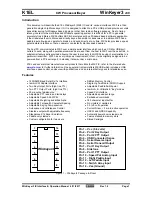
3: Operations
Note:
The default port number for HTTP is 80.
Setting the HTTP authentication method:
The HTTP server supports two authentication methods for security and validation of
the username-password – Basic and MD5 digest.
The Basic method utilizes Base64 encoding to encode and deliver the username-
password over the network to the HTTP server for decoding and authentication. This
basic method is supported by all web browsers and offers a minimum level of
security.
Note:
The Base64 algorithm is widely-known and susceptible to packet-
sniffer attack for acquisition of the encoded username-password string.
The MD5 digest method provides stronger protection utilizing one-way encoded hash
numbers, never placing the username-password on the network. Instead, the
sending browser creates a challenge code based on the hash algorithm, provided
username-password and unique items such as the device IP address and timestamp,
which is compared against the HTTP server internal user database of valid challenge
codes. The MD5 digest method offers a higher level of security than the Basic
method but at present is not supported by all browsers.
Note:
MD5 is known to be fully supported by Internet Explorer 5.0+
Select Basic or MD5 from the Authentication drop-down menu and press
Apply
.
Setting SSL access level
SSL access may be configured as optional or required. The default access level is
set to optional.
Optional –Both non-secure (HTTP) and SSL encrypted connections (HTTPS) are
allowed access.
Required – ONLY SSL encrypted connections (HTTPS) are allowed access.
Select
Optional
or
Required
from the Secure Access drop-down menu and press
Apply
.
Serial Port
The Serial Port configuration page is used for maintenance of the serial port.
Setting the data rate for all serial ports:
1. Select the serial port data rate from the drop-down menu and press
Apply
.
Note:
The default values are 9600 baud, 8 data bits, 1 stop bit, and no parity
(9600 N 8 1).
Setting the serial port timeout value:
1. Enter the timeout value (in minutes) in the Connection Timeout field and press
Apply
.
Creating a descriptive serial name:
1. Click on the
Edit
link in the Action column next to the port to be configured.
SecureLinx SLP Remote Power Manager
21
















































